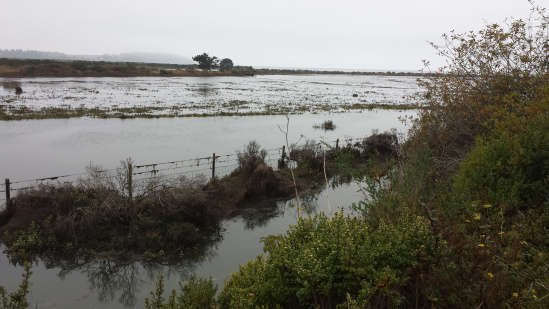Sharp-eyed readers who drive along 101 near College of the Redwoods may have noticed something new last week. Right there, just west of the Tompkins Hill exit, there is now water where there previously was none.
This was especially pronounced last week, as super-high tides gushed through a breached levee near the highway, drowning more than 50 acres of land that had once been reclaimed from the sea and used as pasture. Early this morning the tide was out again, and a congregation of egrets was feeling its way around the new mud.
This is going to be the new regular state of affairs for the parcel known as “White Slough” – sometimes completely underwater, other times a vast expanse of mud. It’s not the best solution, but the land’s current owner – the Humboldt Bay National Wildlife Refuge – is more or less okay with it.
“We’d always planned for it to get restored back to the bay,” refuge manager Eric Nelson told the Outpost last week. “Instead, it appears Mother Nature beat us to it.”
The refuge has long been aware that the dike holding back the sea at White Slough has been in horrible shape, and it’s been planning to restore the area for some time. But the sudden failure of the levee last Saturday means that the refuge didn’t have time to carry out its plans, and the return of the land to the ocean will be less than ideal.
In a perfect world, the land would be restored as salt marsh, which is more or less its original, pre-Columbian state. Humboldt Bay lost most of its salt marsh habitat when settlers diked it off and put cattle on it, and restoring those marshes is everyone’s top priority.
But the land in question has settled and lost elevation over the years. The wildlife refuge’s plan was to bring in fill material and build it back up, so that it would be above the tide often enough to support the vegetation and fauna that make up your typical salt marsh.
The breaching of the levee last Saturday has pretty much scuttled that plan, Nelson said. Instead, with the lower elevation, the land will end up not as marsh but mud flat – still useful habitat for some species, but not as rich or desirable as a marsh.
The premature levee-bust affects the Humboldt Bay Harbor, Conservation and Recreation District, too. Dan Berman, the district’s conservation director, told the Outpost last week that it had been it talks with the refuge to provide the landfill it had hoped to acquire to build the salt marsh. It could have been a place to deposit material the district regularly dredges up from the bottom of the bay in order to keep shipping channels clear. Now it will have to look elsewhere.
Regardless, it seems that no regulatory agency has any issues with the refuge simply giving up on the levee and allowing the ocean to reclaim the land. Mud flats it shall be.

CLICK TO MANAGE